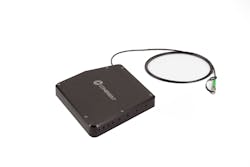Eight-wavelength fiber-delivery optical bus is hot-swappable
Many laser-based instruments (microscopes, flow cytometers, and others) require a clean, low-noise optical-fiber-delivered input, dictating use of singlemode polarization-maintaining fiber. For visible lasers, the core diameter of this type of fiber is around 3.5 μm; coupling the laser light into these fibers requires extreme alignment precision maintained over large ambient temperature changes and typical lab vibrations and shocks. Multiple input wavelengths, as well as the ability to “hot swap,” or add/remove lasers in the field/lab as needed, is also desirable. While the output of two lasers can be efficiently combined by collimating the output of the lasers and using a dichroic beamsplitter and waveplate, then coupling into a fiber, this is a cumbersome solution that is prone to alignment shifts, and becomes far more difficult when combining more than two lasers.
Coherent (Santa Clara, CA) has unveiled an optical bus that addresses this need to combine multiple laser wavelengths into a single instrument (for example, to simultaneously excite multiple fluorophores). Called the OBIS Galaxy, the unit combines the light from up to eight lasers of predefined wavelengths at once. Wavelength-dedicated laser-input sockets use FC/UFC connectors that enable precise mechanical and optical registration; each input is then collimated as a macroscopic beam using a rigidly mounted lens. The optical bus combines all the separate wavelengths into one output beam using a proprietary (patent-pending) design. The fiber into which the light is combined has a constant numerical aperture (NA) across a wide wavelength band. The predefined input wavelengths of the OBIS Galaxy are 405, 445, 458, 488, 514, 532, 552 (or optionally 561), 590, and 642 nm. Lasers can be hot-swapped at any of the inputs with less than a ±5% change in power at the output fiber; operational temperature range of the unit is 10° to 40°C. Contact Dan Callen at [email protected].

John Wallace | Senior Technical Editor (1998-2022)
John Wallace was with Laser Focus World for nearly 25 years, retiring in late June 2022. He obtained a bachelor's degree in mechanical engineering and physics at Rutgers University and a master's in optical engineering at the University of Rochester. Before becoming an editor, John worked as an engineer at RCA, Exxon, Eastman Kodak, and GCA Corporation.
